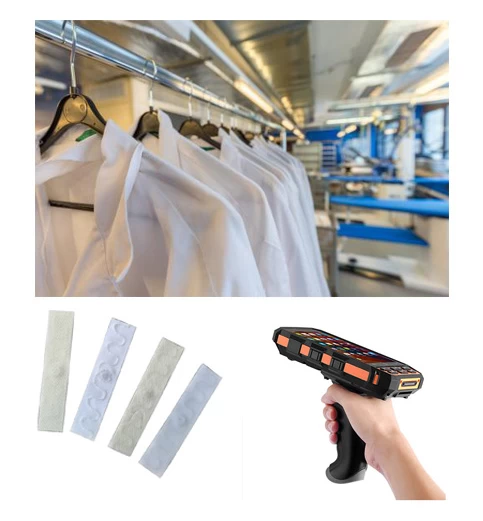RFID Laundry Tag is applicable to laundry and hotel industrial washing applications. It can withstand 180 ℃ high temperature ironing and 200 cycles of industrial washing. Stable and reliable performance.
1. Reduce manual linen sorting
Hospitals, hotels, linen factories or any company dealing with a variety of textiles need to classify linen for cleaning. The sorting process usually requires 2-8 people to divide the linen into different chutes, and it may take several hours to sort all the linen. With the help of the RFID linen management system, RFID laundry tags are sewn on each piece of linen. When the RFID laundry tag passes through the assembly line, the RFID reader will send a query signal and read the tag. After all tags are read, the system will confirm what type of linen is read and send it to the appropriate place or machine. The processing results of the system will be displayed on the screen, so that you can immediately send your linen to the next place.
Enterprises now use RFID laundry tags to eliminate manual linen sorting and greatly reduce the labor expenditure on linen sorting. Instead of relying on the human eye to distinguish the barcode or linen, now only 1-2 people need to be assigned to send the linen to the next program in an orderly manner.
2. Provide accurate cleaning quantity record
The cleaning cycle number of each linen is an important data, and the cleaning cycle number analysis system can effectively help predict the end date of the life of each linen. Most linen can only withstand a certain number of high-strength cleaning cycles, and the linen starts to crack or damage after the rated number of times. Without the number of cleaning records, it is difficult to predict the end of life of each linen. This also makes it difficult for the hotel to make an order plan for replacing old linen.
When the linen comes out of the washing machine, the RFID reader will detect the RFID tag sewn in the linen. Then, the number of cleaning cycles of the uploaded grass is sent to the system database. When the system detects that a piece of linen is approaching the end of its service life, the system will prompt the user to reorder the linen. The plan ensures that the company has the necessary linen inventory, which greatly reduces the replenishment time caused by the loss or damage of linen.
3. Provide fast and simple visual inventory management
Lack of visual inventory management may make it difficult for the company to formulate accurate emergency response plans, achieve effective operation or prevent loss and theft of linen. If a piece of linen is stolen and the company does not implement a daily inventory audit, the company may face the potential risk of delay due to inaccurate inventory management in its daily operation.
UHF RFID laundry tags sewn on each piece of linen can help companies manage daily inventory faster and more effectively. RFID readers placed in each warehouse will perform continuous inventory monitoring to help determine the location of linen lost or stolen. Reading the inventory quantity through RFID can also help companies that use outsourced cleaning services. Before sending the cloth to be washed, read the inventory quantity first, and then read the quantity again after returning the cloth to ensure that the cloth is not lost in the final washing process.
4. Reduce loss and theft
Today, most companies in the world still use simple, human-dependent inventory management methods to calculate the quantity of lost or stolen linen. Unfortunately, when calculating hundreds of pieces of linen, manpower caused many errors. After the statistics, the next step is to try to find out the system vulnerabilities. Generally, when a piece of cloth is stolen, it is almost impossible for the company to find the thief, or even to obtain compensation or return.
The unique EPC serial number in the RFID laundry tag enables enterprises to identify which piece of linen is lost or stolen and understand its final location. If a piece of linen is taken away from a hotel or hospital room, the guests in the room can be charged for the linen to ensure that the enterprise will not suffer losses.
5. Provide meaningful customer information
Companies that rent linen have a unique way to study user behavior and understand customers by renting RFID tags on linen. RFID laundry tags sewn into fabrics help record customer information, such as historical renters, lease dates, lease terms, etc. Keeping these records helps the company understand the popularity of products, product history and customer preferences.
6. Realize accurate check-in and check-out system management
The process of renting linen is usually very complex, unless the company can establish a simple concept to save information, such as lease date, expiration date, customer information, etc. The RFID system provides a customer database, which can not only store important information, but also timely remind enterprises of small matters such as the approaching expiry date of a piece of linen. This function enables enterprises to communicate with customers about the approximate return date and provide it to customers instead of only providing customers to assume the return date. This effectively strengthens the customer relationship. It also reduces unnecessary disputes and increases flax rental income.
Post time: Mar-03-2023


